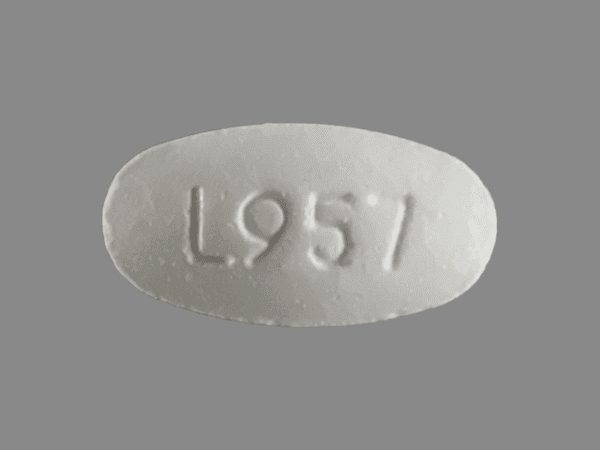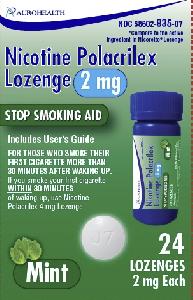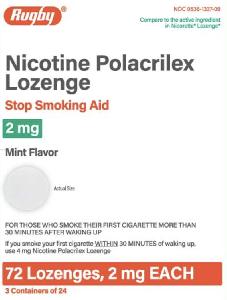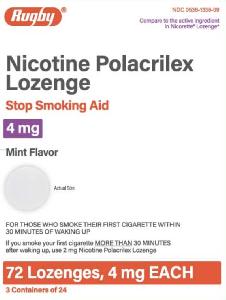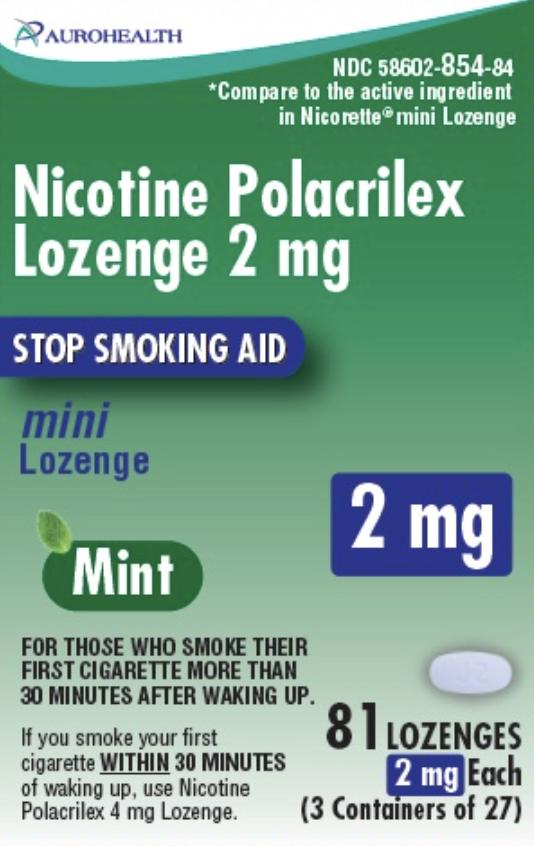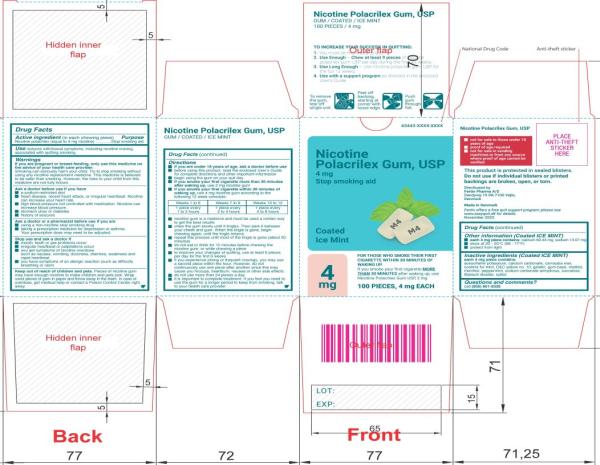Dosage Forms
Excipient information presented when available (limited, particularly for generics); consult specific product labeling. [DSC] = Discontinued product
Gum, Mouth/Throat, as polacrilex:
Nicorelief: 2 mg (50 ea, 110 ea)
Nicorelief: 2 mg (50 ea, 110 ea) [mint flavor]
Nicorelief: 4 mg (50 ea, 110 ea) [contains fd&c yellow #10 (quinoline yellow)]
Nicorelief: 4 mg (50 ea, 110 ea) [contains fd&c yellow #10 (quinoline yellow); mint flavor]
Nicorette: 2 mg (170 ea, 200 ea) [original flavor]
Nicorette: 2 mg (190 ea [DSC]) [contains menthol; fresh mint flavor]
Nicorette: 2 mg (20 ea, 100 ea, 160 ea, 190 ea [DSC]) [contains menthol; fruit flavor]
Nicorette: 2 mg (110 ea [DSC], 170 ea) [contains menthol; mint flavor]
Nicorette: 2 mg (20 ea, 100 ea, 160 ea, 190 ea) [contains menthol, polysorbate 80; cinnamon flavor]
Nicorette: 2 mg (20 ea, 100 ea, 160 ea) [contains menthol, polysorbate 80; mint flavor]
Nicorette: 2 mg (100 ea, 160 ea) [contains menthol, polysorbate 80; spearmint flavor]
Nicorette: 4 mg (170 ea, 200 ea) [contains fd&c yellow #10 (quinoline yellow); original flavor]
Nicorette: 4 mg (100 ea, 160 ea) [contains fd&c yellow #10 (quinoline yellow), menthol, polysorbate 80; cinnamon flavor]
Nicorette: 4 mg (100 ea) [contains fd&c yellow #10 aluminum lake, menthol]
Nicorette: 4 mg (100 ea, 190 ea [DSC]) [contains fd&c yellow #10 aluminum lake, menthol; fresh mint flavor]
Nicorette: 4 mg (20 ea, 100 ea, 160 ea, 190 ea [DSC]) [contains fd&c yellow #10 aluminum lake, menthol; fruit flavor]
Nicorette: 4 mg (110 ea [DSC], 170 ea) [contains fd&c yellow #10 aluminum lake, menthol; mint flavor]
Nicorette: 4 mg (160 ea) [contains fd&c yellow #10 aluminum lake, menthol, polysorbate 80]
Nicorette: 4 mg (20 ea, 100 ea, 160 ea, 190 ea [DSC]) [contains fd&c yellow #10 aluminum lake, menthol, polysorbate 80; mint flavor]
Nicorette Starter Kit: 2 mg (110 ea) [original flavor]
Nicorette Starter Kit: 2 mg (100 ea) [contains menthol]
Nicorette Starter Kit: 4 mg (110 ea) [contains fd&c yellow #10 aluminum lake; original flavor]
Thrive: 2 mg (100 ea) [contains saccharin sodium]
Generic: 2 mg (20 ea, 40 ea, 50 ea, 100 ea, 110 ea); 4 mg (20 ea, 40 ea, 50 ea, 100 ea, 110 ea)
Inhaler, Inhalation:
Nicotrol: 10 mg (168 ea) [contains menthol]
Kit, Transdermal:
Generic: 7 mg/24 hr (14s) & 14 mg/24 hr (14s) & 21 mg/24 hr (28s)
Lozenge, Mouth/Throat, as polacrilex:
GoodSense Nicotine: 4 mg (24 ea) [contains aspartame]
GoodSense Nicotine: 4 mg (72 ea) [contains aspartame; mint flavor]
GoodSense Nicotine: 2 mg (27 ea); 4 mg (27 ea) [gluten free]
Nicorette: 2 mg (72 ea [DSC]) [cherry flavor]
Nicorette: 2 mg (108 ea [DSC]) [contains aspartame]
Nicorette: 2 mg (24 ea, 27 ea [DSC], 72 ea, 168 ea [DSC]) [contains aspartame, soy protein; mint flavor]
Nicorette: 4 mg (72 ea [DSC]) [cherry flavor]
Nicorette: 4 mg (108 ea [DSC]) [contains aspartame]
Nicorette: 4 mg (24 ea, 72 ea, 168 ea [DSC]) [contains aspartame, soy protein; mint flavor]
Nicorette Mini: 2 mg (20 ea, 81 ea, 135 ea); 4 mg (20 ea, 81 ea, 135 ea [DSC])
Nicotine Mini: 2 mg (27 ea) [contains aspartame; mint flavor]
Nicotine Mini: 4 mg (27 ea) [contains aspartame]
Generic: 2 mg (24 ea, 27 ea); 4 mg (24 ea, 27 ea)
Patch 24 Hour, Transdermal:
Nicoderm CQ: 7 mg/24 hr (14 ea); 14 mg/24 hr (14 ea, 21 ea); 21 mg/24 hr (7 ea, 14 ea, 21 ea)
Nicotine Step 3: 7 mg/24 hr (14 ea)
Nicotine Step 2: 14 mg/24 hr (14 ea)
Nicotine Step 1: 21 mg/24 hr (14 ea)
Generic: 7 mg/24 hr (1 ea, 7 ea, 14 ea); 14 mg/24 hr (1 ea [DSC], 7 ea, 14 ea, 28 ea); 21 mg/24 hr (1 ea [DSC], 7 ea, 14 ea, 28 ea)
Solution, Nasal:
Nicotrol NS: 10 mg/mL (10 mL)
Pharmacology
Mechanism of Action
Nicotine, a naturally occurring alkaloid, binds stereo-selectively to nicotinic-cholinergic receptors at the autonomic ganglia, in the adrenal medulla, at neuromuscular junctions, and in the brain. Two types of CNS effects are believed to be the basis of nicotine's positively reinforcing properties; a stimulating effect is exerted mainly in the cortex via the locus ceruleus and a reward effect is exerted in the limbic system. At low doses the stimulant effects predominate while at high doses the reward effects predominate.
Pharmacokinetics/Pharmacodynamics
Absorption
Buccal mucosa, transdermal: Slow; Intranasal: ~53%; Inhaler: <5% reaches the lower respiratory tract
Distribution
2 to 3 L/kg (Svensson 1987)
Metabolism
Hepatic (major), kidney, and lung; >20 metabolites (primarily metabolites are to cotinine (1/5 as active) and trans-3-hydroxycotinine)
Excretion
Urine (~10% as unchanged)
Onset of Action
Intranasal: More closely approximate the time course of plasma nicotine levels observed after cigarette smoking than other dosage forms (Svensson 1987)
Time to Peak
Serum: Transdermal: ~2 to 8 hours (Bannon 1989; DeVeaugh-Geiss 2010); Intranasal: 10 to 20 minutes; Oral inhalation: ≤15 minutes; Gum: ~30 minutes (Svensson 1987)
Half-Life Elimination
Transdermal: ~4 hours (Bannon 1989); Nasal spray: 1 to 2 hours; Inhaler: 1 to 2 hours
Protein Binding
5% to 20% (Svensson 1987)
Use in Specific Populations
Special Populations: Renal Function Impairment
Nicotine clearance is decreased by ~30% and ~50% in moderate and severe renal impairment, respectively.
Special Populations: Hepatic Function Impairment
Nicotine clearance is decreased by ~40% to 50% in moderate hepatic impairment.
Use: Labeled Indications
Smoking cessation: Treatment to aid smoking cessation for the relief of nicotine withdrawal symptoms (including nicotine craving)
Contraindications
Hypersensitivity to nicotine or any component of the formulation.
OTC labeling: Nicorette lozenge: When used for self-medication, do not use if you are allergic to soya.
Dosage and Administration
Dosing: Adult
Smoking cessation (patients should completely stop smoking upon initiation of therapy):
Gum: Chew 1 piece of gum when urge to smoke occurs. If strong or frequent cravings are present after 1 piece of gum, may use a second piece within the hour (do not continuously use one piece after the other). Patients who smoke their first cigarette within 30 minutes of waking should use the 4 mg strength; otherwise the 2 mg strength is recommended. Use according to the following 12-week dosing schedule:
Weeks 1 to 6: Chew 1 piece of gum every 1 to 2 hours (maximum: 24 pieces/day); to increase chances of quitting, chew at least 9 pieces/day during the first 6 weeks
Weeks 7 to 9: Chew 1 piece of gum every 2 to 4 hours (maximum: 24 pieces/day)
Weeks 10 to 12: Chew 1 piece of gum every 4 to 8 hours (maximum: 24 pieces/day)
Inhalation: Oral:
Initial treatment: 6 to 16 cartridges/day (at least 6 cartridges/day for the first 3 to 6 weeks) for up to 12 weeks; maximum: 16 cartridges/day. Note: Best effect achieved with frequent continuous puffing (20 minutes). Use beyond 6 months is not recommended (has not been studied). If patient is unable to stop smoking by the fourth week of therapy, consider discontinuation.
Discontinuation of therapy: After initial treatment, gradually reduce daily dose over 6 to 12 weeks. Some patients may not require gradual reduction of dosage and may stop treatment abruptly.
Lozenge: Oral: 1 lozenge when urge to smoke occurs; do not use more than 1 lozenge at a time. Patients who smoke their first cigarette within 30 minutes of waking should use the 4 mg strength; otherwise the 2 mg strength is recommended. Use according to the following 12-week dosing schedule:
Weeks 1 to 6: 1 lozenge every 1 to 2 hours (maximum: 5 lozenges every 6 hours; 20 lozenges/day); to increase chances of quitting, use at least 9 lozenges/day during the first 6 weeks
Weeks 7 to 9: 1 lozenge every 2 to 4 hours (maximum: 5 lozenges every 6 hours; 20 lozenges/day)
Weeks 10 to 12: 1 lozenge every 4 to 8 hours (maximum: 5 lozenges every 6 hours; 20 lozenges/day)
Nasal: Spray: Initial: 1 to 2 doses/hour (each dose [2 sprays, one in each nostril] contains 1 mg of nicotine); adjust dose as needed based on patient response; do not exceed more than 5 doses (10 sprays) per hour [maximum: 40 mg/day (80 sprays)] or 3 months of treatment. Note: For best results, use at least the recommended minimum of 8 doses per day (less is unlikely to be effective). Use beyond 6 months is not recommended (has not been studied). If patient is unable to stop smoking by the fourth week of therapy, consider discontinuation.
Discontinuation of therapy: Discontinue over 4 to 6 weeks. Some patients may not require gradual reduction of dosage and may stop treatment abruptly.
Transdermal patch: Topical: Note: Adjustment may be required during initial treatment (move to higher dose if experiencing withdrawal symptoms; lower dose if side effects are experienced).
Patients smoking >10 cigarettes/day: Begin with step 1 (21 mg/day) for 6 weeks, followed by step 2 (14 mg/day) for 2 weeks; finish with step 3 (7 mg/day) for 2 weeks
Patients smoking ≤10 cigarettes/day: Begin with step 2 (14 mg/day) for 6 weeks, followed by step 3 (7 mg/day) for 2 weeks
Dosing: Geriatric
Refer to adult dosing.
Administration
Gum: Chew slowly until it tingles, then place gum between cheek and gum until tingle is gone; repeat process until most of tingle is gone (~30 minutes). Do not eat or drink 15 minutes before using or while the gum is in mouth.
Lozenge: Do not chew or swallow; allow to dissolve slowly (~20 to 30 minutes); minimize swallowing and occasionally move lozenge from one side of the mouth to the other until completely dissolved. Do not eat or drink 15 minutes before using or while lozenge is in mouth.
Nasal spray: Prime pump prior to first use (pump 6 to 8 times until fine spray appears) or if it has not been used for 24 hours (pump 1 to 2 times); avoid excessive priming. Blow nose prior to use. Tilt head back slightly and insert tip of bottle into nostril. Breathe through mouth and spray once in each nostril. Do not sniff, swallow, or inhale through the nose during administration. After administration, wait 2 to 3 minutes before blowing nose. Avoid contact with skin, eyes, and mouth (nicotine overdose can occur when nicotine is absorbed through the skin).
Oral Inhalation: Insert cartridge into inhaler and push hard until it pops into place. Replace mouthpiece and twist the top and bottom so that markings do not line up. Inhale deeply into the back of the throat or puff in short breaths. Nicotine in cartridge is used up after about 20 minutes of active puffing. Clean mouthpiece regularly with soap and water.
Transdermal patch: Apply new patch to nonhairy, clean, dry skin on the upper body or upper outer arm; each patch should be applied to a different site. Apply immediately after removing backing from patch; press onto skin for ~10 seconds. Patch may be worn for 16 or 24 hours. If cigarette cravings occur upon awakening, wear for 24 hours; if vivid dreams or other sleep disturbances occur, remove the patch at bedtime and apply a new patch in the morning. Do not cut patch; causes rapid evaporation, rendering the patch useless. Do not wear more than 1 patch at a time; do not leave patch on for more than 24 hours (may irritate skin). Wash hands after applying or removing patch. Discard patches by folding adhesive ends together, replace in pouch and dispose of properly in trash.
Dietary Considerations
Some products may contain phenylalanine and/or sodium.
Storage
Store at room temperature.
Inhaler: Protect cartridges from light.
NicoDerm CQ: Dispose of used patches by folding sticky ends together; place in pouch and discard.
Nicorette gum, Nicorette lozenge and mini lozenge, Nicotrol: Protect from light. Wrap used pieces of gum in paper and discard.
Nicotine Images
Drug Interactions
Adenosine: Nicotine may enhance the AV-blocking effect of Adenosine. Nicotine may enhance the tachycardic effect of Adenosine. Monitor therapy
Cimetidine: May increase the serum concentration of Nicotine. Monitor therapy
Varenicline: May enhance the adverse/toxic effect of Nicotine. Monitor therapy
Adverse Reactions
Nasal spray/inhaler:
>10%:
Central nervous system: Headache (18% to 26%)
Gastrointestinal: Oral irritation (≤66%), dyspepsia (18%)
Respiratory: Nasal discomfort (94%), throat irritation (≤66%), cough (32%), rhinitis (23%)
1% to 10%:
Central nervous system: Pain (>3%), paresthesia (>3%), withdrawal syndrome (>3%)
Dermatologic: Acne vulgaris (3%)
Gastrointestinal: Flatulence (4%), gingival disease (4%), diarrhea (>3%), dysgeusia (>3%), hiccups (>3%), nausea (>3%)
Genitourinary: Dysmenorrhea (3%)
Neuromuscular & skeletal: Back pain (6%), arthralgia (5%), jaw pain (>3%), neck pain (>3%)
Respiratory: Flu-like symptoms (>3%), sinusitis (>3%)
Miscellaneous: Fever (>3%)
<1%: Amnesia, aphasia, bronchospasm, hypersensitivity reaction, increased bronchial secretions, migraine, nonthrombocytopenic purpura, numbness, peripheral edema, skin rash, visual disturbance, xerostomia
Frequency not defined:
Central nervous system: Altered sense of smell, facial paresthesia
Dermatologic: Burning sensation of the nose, facial flushing
Gastrointestinal: Oral paresthesia
Ophthalmic: Burning sensation of eyes, eye irritation, watery eyes
Otic: Otalgia
Respiratory: Epistaxis, hoarseness, nasal congestion, nasal mucosa ulcer, pharyngitis, rhinorrhea, sneezing
Postmarketing: Anaphylaxis, chest pain, dysphagia
Adverse events reported for chewing gum, lozenge, and/or transdermal systems were reported in prescription labeling. Frequency not defined; may be product- or dose-specific:
Cardiovascular: Cardiac arrhythmia, increased blood pressure, palpitations
Central nervous system: Abnormal dreams, sleep disturbance
Dermatologic: Erythema of skin, skin rash
Gastrointestinal: Dyspepsia, heartburn, hiccups, oral irritation, sore throat
Hypersensitivity: Hypersensitivity reaction
Local: Application site reaction, localized edema
Neuromuscular & skeletal: Jaw pain
Warnings/Precautions
Disease-related concerns:
- Cardiovascular disease: Nicotine can increase heart rate and blood pressure. The risk versus the benefits should be weighed in patients with cardiovascular or peripheral vascular diseases, specifically patients with a history of myocardial infarction and/or angina pectoris, serious cardiac arrhythmias, or vasospastic diseases (Buerger disease, Prinzmetal variant angina, Raynaud phenomena); use caution in patients with angina, hypertension, or recent MI. Discontinue use if irregular heartbeat or palpitations occur. Use caution in patients with accelerated hypertension due to the risk of malignant hypertension. Generally, avoid use during the immediate postmyocardial infarction period, in patients with serious arrhythmias, or with severe or worsening angina.
- Diabetes: Use with caution in patients with insulin-dependent diabetes.
- Gastrointestinal disease: Use with caution in patients with esophagitis or active gastric or peptic ulcer disease; healing may be delayed.
- Hepatic impairment: Nicotine clearance is decreased in patients with moderate to severe hepatic impairment; use with caution. Monitor for adverse effects; consider dose reduction.
- Hyperthyroidism: Use with caution in patients with hyperthyroidism.
- Pheochromocytoma: Use with caution in patients with pheochromocytoma.
- Renal impairment: Nicotine clearance is decreased in patients with moderate to severe renal impairment; use with caution. Monitor for adverse effects; consider dose reduction.
Dosage form specific issues:
- Chewing gum: OTC labeling: When used for self-medication, consult a health care provider before use in patients on a sodium-restricted diet and in patients with a history of seizures. Discontinue use and consult a health care provider if mouth, teeth, or jaw problems occur.
- Inhaler: Use with caution in patients with bronchospastic disease (eg, asthma, chronic pulmonary disease); may cause bronchospasm due to potential airway irritation; other forms of nicotine replacement may be preferred in patients with severe bronchospastic airway disease. Sustained use (beyond 6 months) by patients who quit smoking is not recommended.
- Lozenge: OTC labeling: When used for self-medication, consult a health care provider before use in patients on a sodium-restricted diet and in patients with a history of seizures. Discontinue use and consult a health care provider if mouth problems, persistent indigestion, or severe sore throat occurs.
- Nasal spray: Use of nasal product is not recommended with chronic nasal disorders (eg, allergy, rhinitis, nasal polyps, and sinusitis). Exacerbations of bronchospasm have been reported in patients with preexisting asthma; use in patients with severe reactive airway disease is not recommended. Nasal mucosa irritation may occur. Sustained use (beyond 6 months) by patients who quit smoking is not recommended.
- Phenylalanine: Some products may contain phenylalanine.
- Transdermal patch: May contain conducting metal (eg, aluminum); remove patch prior to MRI. OTC labeling: When used for self-medication, consult a health care provider before use in patients who have an allergy to adhesive tape or who have skin problems. Discontinue use and contact a health care provider if skin redness caused by the patch does not resolve after 4 days or if inflammation or rash occurs. If vivid dreams or other sleep disturbances occur, remove the patch at bedtime and apply another patch in the morning.
Other warnings/precautions:
- Appropriate use: Urge patients to stop smoking completely when initiating therapy.
- OTC labeling: When used for self-medication, discontinue use and contact a health care provider if symptoms of nicotine overdose (eg, nausea, vomiting, dizziness, diarrhea, weakness, rapid heartbeat) or an allergic reaction (eg, difficulty breathing, rash) occurs.
Monitoring Parameters
Signs and symptoms of nicotine toxicity (eg, severe headache, dizziness, mental confusion, disturbed hearing and vision, abdominal pain; rapid, weak and irregular pulse; salivation, nausea, vomiting, diarrhea, cold sweat, weakness)
Pregnancy
Pregnancy Considerations
Nicotine crosses the placenta (HHS 2014).
Multiple factors contribute to the toxicity of nicotine (eg, dose, route, and duration of exposure). Nicotine exposure via maternal smoking may increase the risk of orofacial clefts, ectopic pregnancy, preterm delivery, and stillbirth (HHS 2014). It is also associated with the development of intrauterine growth restriction, sudden infant death syndrome (SIDS), placenta previa, placental abruption, ectopic pregnancy, as well as adverse effects on fetal brain and lung tissue (ACOG 721 2017; HHS 2014). Smokeless tobacco and second-hand exposure are also associated with adverse pregnancy outcomes. (ACOG 721 2017; HHS 2014).
All pregnant females should be encouraged to stop smoking (ACOG 721 2017). Following smoking cessation, benefits to the mother and fetus occur at any time during pregnancy, with the most benefits observed when smoking is stopped <15 weeks gestation (ACOG 721 2017; Siu 2015). Although nicotine replacement products are effective in non-pregnant patients, only studies that also provided behavioral support showed effectiveness for smoking cessation during pregnancy (ACOG 721 2017; Coleman 2015; Siu 2015). Available guidelines also note that information related to the maternal and fetal benefits and risks of using nicotine replacement products in pregnancy is limited and often conflicting (ACOG 721 2017; Siu 2015). The benefits of smoking cessation and risks of nicotine exposure should be evaluated with each patient; use of nicotine replacement products during pregnancy should be done under close medical supervision (ACOG 721 2017; Siu 2015).
Patient Education
What is this drug used for?
- It is used to treat nicotine withdrawal and to curb the craving to smoke.
Frequently reported side effects of this drug
- Trouble sleeping
- Nightmares
- Anxiety
- Joint pain
- Back pain
- Application site irritation
- Flu-like signs
- Passing gas
- Tingling of mouth
- Gingival changes
- Constipation
- Runny nose
- Cough
Other side effects of this drug: Talk with your doctor right away if you have any of these signs of:
- Mood changes
- Confusion
- Chest pain
- Fast heartbeat
- Passing out
- Abnormal heartbeat
- Burning or numbness feeling
- Dizziness
- Severe headache
- Vision changes
- Nausea
- Vomiting
- Diarrhea
- Drooling
- Cold sweats
- Tremors
- Loss of strength and energy
- Blurred vision
- Trouble hearing
- Nasal sores
- Sore throat
- Mouth sores
- Jaw pain
- Signs of a significant reaction like wheezing; chest tightness; fever; itching; bad cough; blue skin color; seizures; or swelling of face, lips, tongue, or throat.
Note: This is not a comprehensive list of all side effects. Talk to your doctor if you have questions.
Consumer Information Use and Disclaimer: This information should not be used to decide whether or not to take this medicine or any other medicine. Only the healthcare provider has the knowledge and training to decide which medicines are right for a specific patient. This information does not endorse any medicine as safe, effective, or approved for treating any patient or health condition. This is only a brief summary of general information about this medicine. It does NOT include all information about the possible uses, directions, warnings, precautions, interactions, adverse effects, or risks that may apply to this medicine. This information is not specific medical advice and does not replace information you receive from the healthcare provider. You must talk with the healthcare provider for complete information about the risks and benefits of using this medicine.
